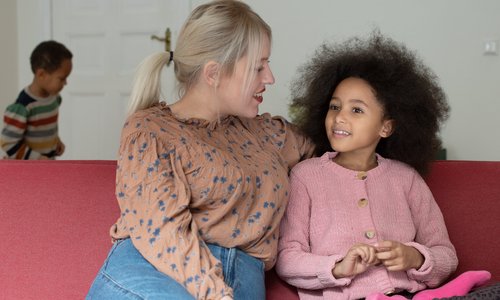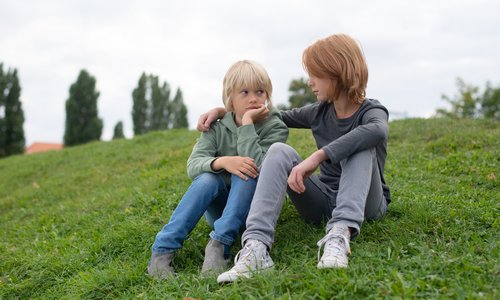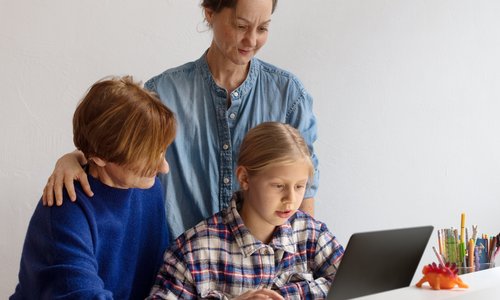
Children and adolescents cannot protect themselves on the internet on their own. The responsibility for ensuring that they can also move around safely online lies with online services and network providers as well as with parents and educational professionals.
Preventive measures from the analogue world can also protect them in cyberspace. However, they must be complemented by further measures that take into account the specific features of online sexual violence.
Protection concepts within cyberspace - responsibility of online providers
Cyberspaces such as online games or chat rooms should have integrated protective measures and provide help for children and adolescents, as in schools or sports clubs. Online services must ensure that these environments become safer through comprehensive prevention concepts against sexual violence. This includes general guidelines against sexual assault and penalising rule violations as well as age-appropriate and low-threshold reporting and complaint options, age verification procedures, chat moderation and easily accessible help offers for anyone suffering from online sexual abuse. Under the Youth Protection Law (JuschG), which came into force in May 2021, minimum protection concept requirements for online providers were legally established for the first time and the legal basis for their implementation was stipulated.
Prevention in educational institutions and families
In particular, families and educational institutions should actively support children and adolescents during their digital participation in society and reduce the risks that might arise online by providing information and help.
However, parents and professionals can only support children and adolescents in a meaningful way if they know what forms of violence minors can be exposed to in cyberspace. This is why advanced training for professionals about protection and help in cases of online sexual violence is just as important as passing on this knowledge to parents.
It is especially important that parents and professionals signal an open attitude towards digital environments to minors. If children and adolescents notice that they encounter a sceptical or even a negative attitude from adults, it will be difficult for them to turn to them with confidence if they are experiencing abusive sexting, cyber-grooming or if they are being confronted with pornographic depictions.

Prevention through modern media and sexual education
Children and adolescents can gain media and digital participation skills through modern media education and they are also informed about their protective rights, which do apply in the cyberspace as well and they are taught about online risks. Their self-protection abilities, which grow with age, will be bolstered through this. This will enable them to better recognise online sexual violence and set limits for themselves, e.g. by disclosing personal data sparingly and critically reflecting on what they share online with strangers.
However, self-protection of children and adolescents also has limits online due to their development. For example, it is hardly possible for children to adequately assess risks and to recognise the sexual intentions and expectations of a digital counterpart. With regard to adolescents, increased risky behaviour (online and offline) can be part of normal development that can only be countered to a limited extent through risk education.
Modern sexual education can also explain and help protect in addition to media education. It should also enable adolescents to develop a open and self-confident sexuality - online as well. Today sexual development is taking place digitally for virtually all adolescents. This often results in online contacts that can be used to commit sexual violence. However, the adolescents are not to be blamed in the event of assaults as it is always those from whom the assaults originate that must be blamed. An open approach to questions about sexuality and sexual development is a condition for adolescents to seek help in these cases.
Education and help in cases of sexual assaults amongst children and adolescents
A comprehensive and differentiated view of online sexual violence includes the realisation that children and adolescents themselves also commit online sexual assaults (e.g. abusive sexting, forwarding pornography to minors or distributing abuse depictions) and the knowledge of how to help those suffering in this type of situation.
If a child or adolescent has the courage to speak up about a sexting problem or a grooming experience, then this is a difficult but courageous step and it should be rewarded accordingly.
Targeted children and adolescents feel completely at their mercy in abusive situations and suffer from a loss of control. They then become very afraid that their family, their friends or teachers will find out. They are also ashamed of what they have experienced and they usually blame themselves for being naïve and letting themselves be deceived. Therefore it is even more important that they find low-threshold services and are encouraged to seek help.
It is important for parents and professionals to talk about digital media sexual violence in an age-appropriate way. This also means that the blame should never be passed on to the children or adolescents in the event of assaults despite these assaults being forbidden in cyberspace: "Why did you send images like that?", rather those targeted need comfort and clarification that the perpetrator has abused their trust and therefore bears all responsibility.
Help for children, adolescents, parents and professionals
Children and adolescents as well as parents and professionals also have the possibility to contact help infrastructures on the internet. Many counselling centres now provide online counselling. Targeted adolescents also have the possibility to receive peer-to-peer counselling from other young people:
Sexual Abuse Telephone Helpline (nationwide, free-of-charge and anonymous): 0800 22 55 530
Online counselling provided by the Sexual Abuse Telephone Helpline: https://www.hilfe-portal-missbrauch.de/online-beratung
Juuuport (for youngsters): www.juuuport.de
Youth support (for youngsters): www.jugend.support
Information and materials about protecting children and adolescents from sexualised violence in cyberspace:






